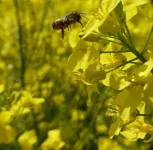(Press-News.org) Hundreds of genetic drivers affect sexual and reproductive behaviour
Combined with social factors, these can affect longevity and health
An Oxford-led team, working with Cambridge and international scholars, has discovered hundreds of genetic markers driving two of life's most momentous milestones - the age at which people first have sex and become parents.
In a paper published today in Nature Human Behaviour, the team linked 371 specific areas of our DNA, called genetic variants (known locations on chromosomes), 11 of which were sex-specific, to the timing of first sex and birth. These variants interact with environmental factors, such as socioeconomic status and when you were born, and are predictors of longevity and later life disease.
The researchers conducted a Genome-Wide Association Study (GWAS), a search across the entire human genome, to see if there is a relationship between reproductive behaviour and a particular genetic variant. In the largest genomic study ever conducted to date, they combined multiple data sources to examine age at first sex (N=387,338) and birth (N=542,901) in men and women. They then calculated a genetic score, with all genetic loci combined explaining around 5-6% of the variability in the average age at sexual debut or having a first child.
Professor Melinda Mills, Director of the Leverhulme Centre for Demographic Science at the University of Oxford and Nuffield College, and the study's first author says, 'Our study has discovered hundreds additional genetic markers that shape this most fundamental part of our lives and have the potential for deeper understanding of infertility, later life disease and longevity.'
The genetic signals were driven by social factors and the environment but also by reproductive biology, with findings related to follicle-stimulating hormone, implantation, infertility, and spermatid differentiation.
Professor Mills adds 'We already knew that childhood socioeconomic circumstances or level of education were important predictors of the timing of reproduction. But we were intrigued to find literally not only hundreds of new genetic variants, but also uncover a relationship with substance abuse, personality traits such as openness and self-control, ADHD and even predictive of some diseases and longevity .'
Professor Mills says, 'We demonstrated that it is a combination of genetics, social predictors and the environment that drives early or late reproductive onset. It was incredible to see that the genetics underlying early sex and fertility were related to behavioural dis-inhibition, like ADHD, but also addiction and early smoking. Or those genetically prone to postpone sex or first birth had better later life health outcomes and longevity, related to a higher socioeconomic status in during childhood.'
Genetic factors driving reproductive behaviour are strongly related to later life diseases such as Type 2 diabetes and cardiovascular disease.
'It is exciting that the genetics underlying these reproductive behaviours may help us understand later life disease.'
Professor Mills concludes, 'Starting your sexual journey early is rooted in childhood inequality but also has links with health problems, such as cervical cancer and depression. We found particularly strong links between early sexual debut, ADHD and substance abuse, such as early age at smoking. We hope our findings lead to better understanding of teenage mental and sexual health, infertility, later life disease and treatments to help.'
INFORMATION:
The study, Identification of 371 genetic variants for age at first sex and birth linked to externalising behaviour, (DOI: 10.1038/s41562-021-01135-3), can be found after the embargo lifts here: https://www.nature.com/articles/s41562-021-01135-3.
Funding was provided to M.C.M. by the European Research Council, SOCIOGENOME (615603), CHRONO (835079), ESRC/UKRI SOCGEN (ES/N011856/1), Wellcome Trust ISSF, Leverhulme Trust and Leverhulme Centre for Demographic Science, to N.B. by ERC GENPOP (865356), to F.C.T. by LabEx Ecode, French National Research Agency (ANR) Investissements d'Avenir (ANR-11-LABX-0047), to M.d.H. by Swedish Heart-Lung Foundation (20170872, 20200781, 20140543, 20170678, 20180706 and 20200602), Kjell and Märta Beijer Foundation and Swedish Research Council (2015-03657, 2019-01417). The funders had no role in study design, data collection and analysis, decision to publish or preparation of the manuscript.
Leverhulme Centre for Demographic Science:
The Leverhulme Centre for Demographic Science (LCDS) was set up in 2019 to build an internationally recognized and interdisciplinary centre of demographic science that will disrupt, realign and raise the value of demography in science and society. For more information about the Trust, please visit http://www.leverhulme.ac.uk and follow the Trust on Twitter @LeverhulmeTrust
The University of Oxford
Oxford University has been placed number one in the Times Higher Education World University Rankings for the fifth year running, and at the heart of this success is our ground-breaking research and innovation. Oxford is world-famous for research excellence and home to some of the most talented people from across the globe. Our work helps the lives of millions, solving real-world problems through a huge network of partnerships and collaborations. The breadth and interdisciplinary nature of our research sparks imaginative and inventive insights and solutions.
People who have lost their sense of smell are being failed by healthcare professionals, new research has revealed.
A study by Newcastle University, University of East Anglia and charity Fifth Sense, shows poor levels of understanding and care from GPs and specialists about smell and taste loss in patients.
This is an issue that has particularly come to the forefront during the Covid-19 pandemic as many people who have contracted the virus report a loss of taste and smell as their main symptoms.
Around one in 10 people who experience smell loss as a result of Covid-19 report that their sense of smell has ...
In a new publication from Opto-Electronic Advances; DOI 10.29026/oea.2021.210040, Researchers led by Professor Daewook Kim from The University of Arizona, Tucson, AZ, USA consider advances in optical engineering for future telescopes.
Astronomical advances are largely coupled with technological improvements - from the invention of the first optical telescope used by Galileo in 1609 and for the foreseeable future, astronomy and optical engineering will be forever linked. This paper summarizes several advances that will enable future telescopes to expand scientific understanding of the universe. Significant optical engineering advances at the University of Arizona are being made for design, fabrication, and construction of next ...
BLOOMINGTON, Ind. -- Scientists at Indiana University have found that significant amounts of the two main components of cannabis, THC and CBD, enter the embryonic brain of mice in utero and impair the mice's ability as adults to respond to fluoxetine, a drug commonly used to treat anxiety and depression and known by the brand name Prozac.
The study suggests that when the developing brain is exposed to THC or CBD, normal interactions between endocannabinoid and serotonin signaling may be diminished as they become adults.
"Hemp-derived CBD is a legal substance in the U.S., and we are in a time of increasing state-level legalization of cannabis. ...
A team of researchers from the University of Cambridge, University College London, University of Oxford, and University of Brescia/RFF-CMCC European Institute on Economics and the Environment carried out the first systematic analysis of the relative performance of probabilistic cost forecasts from expert-based methods and model-based methods.
They specifically focused on one expert-based method -- expert elicitations -- and four model-based methods which model costs either as a function of cumulative installed capacity or as a function of time. The results of this ...
Researchers have developed a more efficient platform for studying proteins that play a key role in regulating gene expression. The approach uses engineered yeast cells to produce enzyme and histone proteins, conduct biochemical assays internally, and then display the results.
"Biomedical and biotech researchers are interested in the mechanisms that allow histones to regulate gene activity," says Alison Waldman, first author of a paper on the work and a Ph.D. student at North Carolina State University. "But the conventional tools for histone research are unwieldy ...
Mass-flowering crops such as oilseed rape or faba bean (also known as broad bean) provide valuable sources of food for bees, which, in turn, contribute to the pollination of both the crops and nearby wild plants when they visit. But not every arable crop that produces flowers is visited by the same bees. A team from the University of Göttingen and the Julius Kühn Institute (JKI) in Braunschweig has investigated how the habitat diversity of the agricultural landscape and the cultivation of different mass-flowering crops affect wild bees. The research shows that diverse agricultural landscapes increase the species richness ...
A team led by Skoltech professor Artem R. Oganov studied the structure and properties of ternary hydrides of lanthanum and yttrium and showed that alloying is an effective strategy for stabilizing otherwise unstable phases YH10 and LaH6, expected to be high-temperature superconductors. The research was published in the journal Materials Today.
Cuprates had long remained record-setters for high-temperature superconductivity until H3S was predicted in 2014. This unusual sulfur hydride was estimated to have high-temperature superconductivity at 191-204 K and was later obtained experimentally, setting a new record in superconductivity.
Following this discovery, many scientists turned to superhydrides, which are abnormally rich in hydrogen, and discovered new compounds that ...
Laboratories are an inherent part of technology qualifications, as practical experiments are essential for students to acquire the competencies and skills that they will need during their future professional development. Providing this learning in a virtual format is one of the challenges posed by the current COVID-19 pandemic--a challenge that distance universities have been addressing for years. RLAB-UOC is a remote laboratory designed and developed by the Universitat Oberta de Catalunya (UOC) that enables students in the Faculty of Computer Science, Multimedia and Telecommunications to conduct practical experiments with real electronic and communications equipment anywhere, at any time. A new article published in the scientific journal Electronics has described the characteristics ...
Near-death experiences are known from all parts of the world, various times and numerous cultural backgrounds. This universality suggests they may have a biological origin and purpose, but exactly what this could be has been largely unexplored.
A new study conducted jointly by the University of Copenhagen (Denmark) and the University of Liege (Belgium) and published in Brain Communications shows how near-death experiences in humans may have arisen from evolutionary mechanisms.
"Adhering to a preregistered protocol, we investigated the hypothesis that thanatosis is the evolutionary origin of near-death experiences", says Daniel Kondziella, a neurologist from Rigshospitalet, Copenhagen University Hospital.
When attacked by a predator, as a last resort defense mechanism, ...
An affordable lab system that uses grass blades to turn cells into cultured meat has been developed at the University of Bath in the UK.
Researchers have successfully taken grass from the university's campus and used it to create a scaffold that animal cells can attach to and grow on. The resulting tissue has the potential to be used both as lab-made meat and as human muscle tissue to repair or replace tissue which has been damaged or lost through injury or disease.
The study, by Dr Paul De Bank (Department of Pharmacy & Pharmacology), Professor Marianne Ellis (Department of Chemical Engineering) and Scott Allan (a PhD researcher in the Department of Chemical Engineering), is published in this month's Journal of ...



